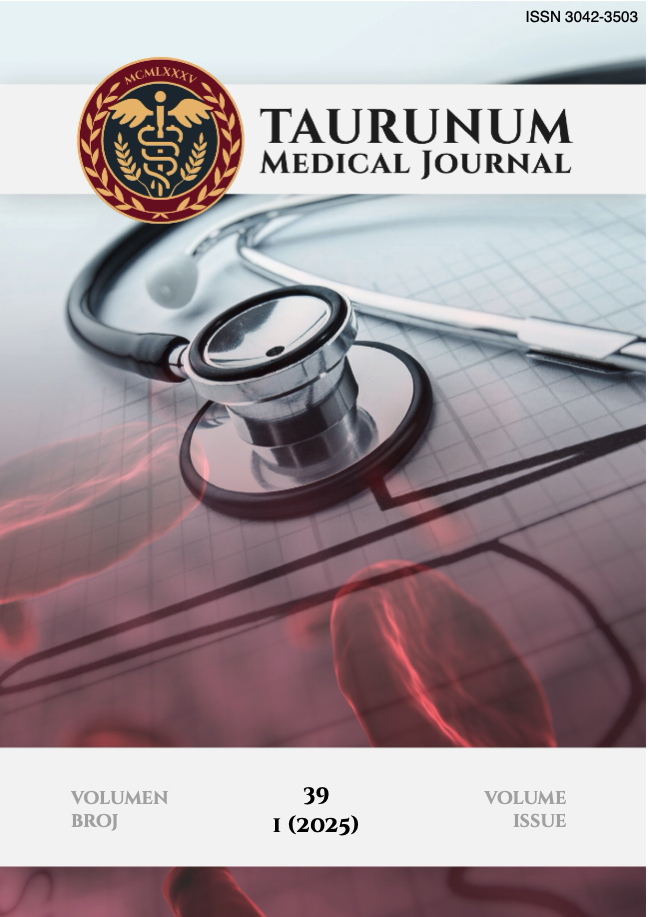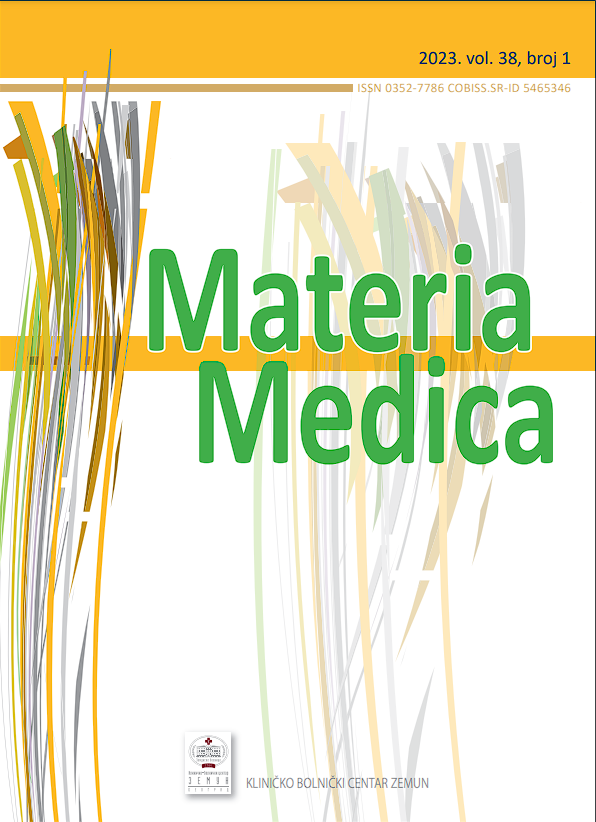Current issue

Volume 39, Issue 1, 2025
Online ISSN: 3042-3511
ISSN: 3042-3503
Volume 39 , Issue 1, (2025)
Published: 31.03.2025.
Open Access
Welcome to Issue 39, No. 1 – the first of our two annual publications for this year. Inside, you'll find a curated selection of articles. Start your year with the essential knowledge and perspectives offered in this timely edition
All issues
Contents
01.04.2018.
Poster session
Comparative study of bronchial brushing and transbronchial needle aspiration cytology in diagnosing lung cancer
Aim: To compare sensitivity, specificity and accuracy of bronchial brushing (BB) and transbronchial needle aspiration (TBNA) cytology in diagnosing lung cancer and to correlate and compare them with corresponding histopathology. Introduction: Lung cancer is a leading cause of death worldwide in both genders. Various cytological techniques such as BB and aspirate, TBNA, bronchoalveolar lavage, transthoracic and pleural puncture can aid in early diagnosis of lung malignancies. Material and Methods: One-year retrospective study included 359 patients with suspected lung cancer who underwent bronchoscopy. During bronchoscopy, cytopathological samples were obtained for smears using BB and TBNA as well as biopsy for histopathological examination that was considered the gold standard . All the samples were microscopically examined and statistically analyzed using descriptive methods and non-parametric Kendal-tau correlation coefficient (the level of significance p<0.05). Results: Sensitivity of BB and TBNA cytology comparing to histopathology was 97.17% and 98.32% respectively whereas specificity was 97.26% and 97.75 % respectively. Positive predictive value was 97.14% in BB and 99.66% in TBNA and negative predictive value was 93.23% in BB and 98.77% in TBNA. The accuracy of BB was 96.51% and 99.14% of TBNA cytology. Discordance of BB cytological and histopathological diagnosis was in 3.21%, whereas discordance of TBNA was in 2.03% cases. There was no statistically significant difference neither between BB (p=0.550) nor between TBNA (p=0.602) cytology and histopathological diagnosis. Conclusion: Cytology is valuable and useful in establishing lung cancer diagnosis, which yields almost the same information as histopathology no matter which method of cytological sampling is used.
Jelena Dzambas, Vesna Skuletic, Zeljka Tatomirovic, Ivan Aleksic, Ljiljana Tomic, Snezana Cerovic
01.04.2018.
Poster session
Primary endobronchial synovial sarcoma
Aim: We present the case of a woman with endobronchial pulmonary synovial sarcoma. Introduction: Primary pulmonary synovial sarcoma is an extremely rare tumor that has the same histomorphological characteristics and chromosomal translocations as the synovial sarcoma of soft tissue origin. Material and Methods: A woman aged 58 years, the smoker, without the current symptoms of the disease, came to our institution because of the nodus that was seen on the CT chest. The polip (26 mm) was located in the lumen of the lower right lobar bronchus. The mediastinal and hilar lymph nodes were not increased. The radiological examination was done as part of a routine control after the meningeoma surgery three years ago. Right lower lobectomy and resection of regional lymph nodes were performed. Results: By a macroscopic examination, in the lumen of the bronchus for the lower right lobes, a clearly limited, nonencapsulated, grayish-white node of 2.6 x 2.6 x 1 cm was found. Histologically, the tumor was showed interweaving fascicular uniform spindle cell with ovoid, pale staining nuclei, and inconspicuous nucleoli, scant cytoplasm and the cell borders indistinct. Immunohistochemical tumor cells were positive for CD99, bcl2 and vimentin. Surgical margins and regional lymph nodes were not affected. A detailed clinical and radiological examination confirmed the primary lung origin of the diagnosed synovial sarcoma. A year after surgery the patient feels good. Conclusion: Morphological and immunohistochemical analysis with detailed clinical and radiological examination confirms the primary lung origin of synovial sarcoma
Dragana Tegeltija, Aleksandra Lovrenski, Golub Samardzija, Tijana Vasiljevic, Misel Milosevic, Zivka Eri, Dejan Vuckovi
01.04.2018.
Poster session
The relationship between thyroid gland transcriptiom factor expression and epidermal growth factor receptor mutation in the lung adenocarcinoma
Aim: To determine the degree of correlation between TTF-1 (+) expression and EGFR mutation status in lung adenocarcinoma. Introduction: Adenocarcinoma of the lung is mainly diagnosed based on standard morphological criteria. The thyroid gland transcription factor (TTF-1) is currently the most commonly used immunohistochemical marker in the differentiation of invasive adenocarcinoma of the lung from another primary and metastatic carcinoma, has a prognostic significance and is a predictor of the EGFR mutation status. Material and Methods: This retrospective study enrolled 60 patients with histologically confirmed primary lung adenocarcinoma who underwent lung cancer surgery at Institute for lung disease Vojvodina between 2010 and 2015. Tumor specimens of these patients were investigated for TTF-1 expression and mutations in EGFR using immunohistochemistry and PCR analysis. Statistical analysis is in statistic software Statistica 12. Results: The study included 35 men and 25 women, with an average age of 61.8 ą 8.08 years. Of the 60 cases, TTF-1 ( ) expression was recorded in 52 (87%) (p <0.001), the statistical difference is not significant when comparing smoking habitsby gender, and tumor size among them. EGFR ( ) mutation status was found in 3/60 (5%) cases [egzon 21 (2) and exon 20 (1)], of which TTF-1 (+) expression was in two cases. Conclusion: There is a statistically significant difference between the TTF-1 (-) and TTF-1 (+) adenocarcinoma and a high degree of correlation between EGFR mutation status and TTF-1 (+) expression.
Dragana Tegeltija, Aleksandra Lovrenski, Golub Samardzija, Tijana Vasiljevic, Vladimir Zecev, Zivka Eri, Dejan Vuckovic
01.04.2018.
Poster session
Reliability of determination of steroid and human epidermal growth factor 2 receptors expression and tumor molecular subtypes in breast core biopsy
Aim: To investigate concordance rate between the results of expression of steroid receptors, human epidermal growth factor 2 receptors (Her2) and determined molecular subtypes in surgical specimens (SS) and samples obtained by core biopsy (CB). Introduction: CB is widely accepted method in the initial diagnosis of breast cancer, but its reliability in determining the status of steroid and Her2 receptors, Ki67 index and molecular subtypes is still a matter of debate. Material and Methods: We analyzed 54 cases of invasive breast cancer, in which the expression of estrogen (ER), progesterone (PR) and Her2 receptors and Ki67 index were determined both in CB and SS. Concordance rate for ER, PR and Her2 receptors expression and molecular subtypes, between CB and SS, was calculated using k-test (p<0.001). Results: The average age of patients was 62. In SS, Luminal A subtype was most commonly diagnosed (48%), followed by: Luminal B Her2-(31%) and TNBC (13%), while Luminal B Her2 and Her2-enriched subtypes were represented by 4% each. Frequencies of molecular subtypes in CB were: Luminal A (41%), LuminalB Her2- (33%), TNBC (15%), Luminal B Her2 (7%), Her2-enriched (4%). Concordance rate for ER receptors was 93.8%(Kappa=0.936), for PR 77.5%(Kappa=0.773), for Her2 80.0%(Kappa=0.78) and for molecular subtypes 80.9%(Kappa=0.753). Conclusion: Statistical analysis showed very good agreement in terms of determined molecular subtypes and ER receptors expression and good agreement for the expression of PR and Her2 receptors. CB represents reliable method for determining the status of expression of steroid and Her2 receptors, as well as tumor molecular subtypes.
Janja Raonic, Ljiljana Vuckovic, Jelena Vucinic, Filip Vukmirovic, Mileta Golubovic, Tanja Nenezic, Tatjana Culafic, Tanja Nenezic, Mirjana Miladinovic
01.04.2018.
Poster session
EGFR mutations in lung carcinomas and quality of samples tested at Institute of Pathology, School of Medicine in Belgrade
Aim: To examine the quality of tested lung carcinoma samples, frequency and type of EGFR mutations, and their correlation with patients clinical characteristics (gender, age, smoking habits, clinical stage). Introduction: Mutations in Epidermal Growth Factor Receptor (EGFR) have a role in lung carcinoma development and they are more prevalent in women and non-smokers. Evaluation of EGFR mutations in lung carcinomas in mandatory for targeted therapy with tyrosine kinase inhibitors. Test performance depends on the quality of tested samples and a test type. Material and Methods: We evaluated reports of EGFR mutation real-time PCR analyses in lung carcinoma samples performed from June 2017 till February 2018. Presence of mutations was correlated with clinical characteristics of lung carcinoma patients. Results: A total of 341 samples was received for testing, among which 40 (11.7%) was unsuitable for analysis due to a low tumor cell content (<5%). Three types of mutations were detected in a total of 24 (8%) cases: L858R in 12 (50%) cases, exon 19 deletion in 10 (41.7%) cases, and G719A/C/S in two cases (8.3%). Mutations were more prevalent in women (13.7%) then in men (4.3%) (p=0.004). Patients with EGFR mutated tumors were older (67,6ą9,4 years), compared to those with non-mutated tumors (62,3ą8,8 years) (p=0,003). Smoking habits and clinical stage were not associated with mutation status in lung carcinomas. Mutations were detected only in adenocarcinomas. Conclusion: Our results suggest the low frequency of EGFR mutations in tested patients, but they are more prevalent in women and older patients.
Sanja Cirovic, Sofija Glumac, Nevena Pandrc, Zorica Tojaga, Ivan Zaletel, Jovan Jevtic, Violeta Mihailovic Vucinic, Natalija Samardzic, Sanja Radojevic Skodric, Martina Bosic
01.04.2018.
Poster session
Anaplastic lymphoma kinase gene rearrangement in benign skin tumors: Report of two cases
Aim: Report of two cases of benign skin tumors of different histogenesis with anaplastic lymphoma kinase (ALK) gene rearrangement. Introduction: ALK gene mutation or rearrangement positive tumors (ALKomas) are heterogeneous group in which such genetic finding has diagnostic or predictive value. ALK gene fusions are associated with tumorigenesis of some cutaneous tumors, e.g. plexiform Spitz nevus (PSN) and epithelioid fibrous histiocytoma (EFH). Cases reports: Histological, immunohistochemical (IHC) and genetic characteristics were analyzed in two skin tumors with ALK gene rearrangement proved by fluorescent in situ hybridization (FISH). First case is PSN localized on face in a 8-year-old boy. Tumor was consisted of spindle cells arranged in plexiform growth pattern throughout epidermis and dermis, with following IHC characteristics: HMB45 focally, p16 , Ki67 in 1% of cells. Deletion of CDKN2A gene was not detected in significant number, while ALK gene rearrangement was positive in 37/50 (74,2%) of cells. Second case is EFH localized on shoulder in a 16-year-old girl. This dermal based tumor was consisted of tightly packed large epithelioid cells, which were CD68 , p16 , S100-, HMB45-, SOX10-, CD1a-, Ki67 (<5% of cells). ALK gene rearrangement was positive in 24/100 (24%) of cells, and focal chromosome 2 polysomy was noted. Neither mitoses nor necrosis were present in any of presented cases. Conclusion: Skin ALKomas are tumors with heterogeneous histological and immunohistochemical characteristics, and also with variable extent of ALK rearrangement.
Milena Jovanovic, Sanja Cirovic, Martina Bosic
01.04.2018.
Poster session
Lobular endocervical glandular hyperplasia vs. Minimal deviation adenocarcinoma: case report
Aim: Lobular endocervical glandular hyperplasia is very rare, differential diagnostic difficult entity, which often mimics more aggressive endocervical lesions, with worse prognosis. Introduction: Lobular glandular endocervical hyperplasia(LEGH) is benign lesion with lobular proliferation of endocervical glands and endocervical epithelium without or with minimal nuclear atypia. Lobular structure can be deep into the cervical tissue without stromal invasion, which is important difference between adenocarcinoma of minimal deviation(MDA), well-differentiated endocervical type of adenocarcinoma, similar to LEGH. Case report: The patient is 50 years, with demarcated, nodular, multicystic tumor, localized deep in cervical tissue. Microscopic analysis shows numerous cystically dilated endocervical glands with lobular presentation, surrounded by hyperplastic fibrous stroma. Glandular acini are diffusely localized, with centrally dilated acinus and peripheral smaller tubular structures. Glands are without the presence of architectural changes and cytonuclear atypia, with uniform, endocervical epithelium.Immunochemical analysis showed:CEA- /CA125focal /p16 focal /Er and Pr focal epithelium, diffusely in stroma. Because structures were described deep in the cervical tissue, MDA is considered diagnostically differential. However, glands do not show signs of distortion(architectural atypia), which is important feature of this entity, as well as no pronounced surrounding desmoplastic stromal reaction. Macroscopic tumor is well demarcated, and the CEA marker is negative, which also suggested LEGH. Conclusion: LEGH and MDA show a quiet clinical and histological similarity. Association of LEGH(50%) with MDA and 40% with cervical adenocarcinoma has been demonstrated, suggesting the possible precancerous potential of LEGH. Research of the lesion microenvironment could be an interesting subject for further research.
Ljubiša Jovanović, Simić Ljubica, Stefanović Radomir, Vrtikapa Jelena, Pajević Mila, Atanacković Jasmina, Milenković Svetlana
01.04.2018.
Poster session
Clinical significance of cd34 expression in endometrioid carcinoma of the uterine body
Aim: Our aim is to examine the expression of CD34 in the endometrioid carcinoma (EC) of the uterine body and association of neoangiogenesis with classical clinical and prognostic parameters. Introduction: The incidence rate increases with age, so in about 75% of cases it occurs in postmenopausal women.Material and Methods: On the biopsy samples obtained after the hysterectomy of 36 patients operated from EC of the uterine body, operated in the General hospital Pirot, where applied routine H E and the imunohistochemical ABC method with anti-CD34 antibodies. Based on the expression of CD 34, the microvascular density per mm2 of the tissue was calculated stereometrically. For statistical analysis SPSS software package were used (version 19.0). Results: The significantly pronounced expression of CD34 is present in all cases of tumors in pT2a to pT3a, and in all cases of the IIA-IIIA FIGO stage. A significantly high neoangiogenesis index is present in 72% of moderately differentiated tumors, in about 70% of tumors with moderate/expressed nuclear atypies, in 92% of cases with microvascular invasion and in 76,5% of tumors affecting over 50% of myomterium. CD34 expression is in positive, moderate and significant correlation with invasion of lymph vessels, pathological stage of the tumor and invasion of blood vessels and myometrium (kk=0,636 - 0,587). The correlation between this marker and the histological and nuclear tumor grade is weaker (kk=0,444 and 0,410). Conclusion: Significant association of CD34 with the aggressive phenotype of the EC of uterine body has significant prognostic implications.
Tomislav Jocic, Milena Rakocevic
01.04.2018.
Poster session
Metastasis of Melanoma to Uterine Leiomyoma
Aim: To highlight the widespread metastatic potential of the cutaneous melanoma, as well as its tendency for unusual presentation of metastatic disease. Introduction: Melanoma is an aggressive, highly malignant disease that is derived from melanocytes. The incidence of melanoma is significantly increasing. Melanoma has a strong tendency for metastasis. After primary excision of tumour, about 30% of all patients shall develop distant metastasis within first 5 years after tumour diagnosis. Case report: A 48-year-old female patient had undergone a hysterectomy because of myomatous uterus. After pathohistological examination metastasis of melanoma was diagnosed in one of multiple leimyoma. Diagnosis was confirmed with positive immunohistochemical staining with MART1 and S100 protein. Insight into the medical records, revealed that patient was diagnosed with superficially spreading melanoma (Clark IV, Breslow III) on skin above her left breast, as well as 2 regional tumour-involved lymph nodes (pT3aN2bM0), 2 years prior to this hysterectomy. Uterine leiomyoma was the first diagnosed distant metastasis of cutaneous melanoma. Diagnosis of stadium IV melanoma was established. Conclusion: Melanoma is a particularly aggressive disease with unpredictable evolution, so the occurrence of metastases in unusual and unexpected localizations, as is the distant benign tumour in the presented case, shall probably happen more often in the future.
Jelena Amidzic, Nada Vuckovic, Aleksandra Fejsa Levakov, Nenad Solajic, Matilda Djolai, Jelena Ilic Sabo, Milan Popovic
01.04.2018.
Poster session
Pathohistological evaluation of tumor regression at breast cancer after neoadjuvant therapy
Aim: Evaluation of pathological estimation results of therapeutic response of primary breast carcinoma to applied neoadjuvant therapy. Introduction: Breast carcinoma is heterogeneous disease, that could be classified into several molecular subtypes by using immunohistochemical analysis and in situ hybridization. Neoadjuvant therapy is applied in cases of locally advanced breast carcinoma and for tumor chemosensitivity evaluation, which is very significant for disease prognosis. Material and Methods: The research was conducted on 35 female patients, that were treated with radical mastectomy in 2017, after IV cycle of neoadjuvant therapy, in Clinical Centre of Montenegro. Before treatment, all patients underwent core biopsy (confirmed invasive breast carcinoma, molecular subtype determined).Pathohistological response of primary tumor to applied therapy was estimated as complete response (pCR), partial response (pPR) and no response (pNR). Results: Average age in examined group of patients was 59,25 years.In 68,58% of cases it was invasive ductal, in 17,14% invasive lobular and in 14,28% mixed invasive carcinoma. Representation of molecular subtypes was (without change in respect to the core biopsy): 34,28% Luminal A, 42,85% Luminal B Her2 negative, 5,71% Luminal B Her2 positive, 8,58% Her2 positive and 8,58% triple negative. In 6 patients (17,15%) pCR was obtained, in 21 (71,42%) pPR, and in 4 (11,43%) no response. In group of patients confirmed for pCR, it was Her2 positive or triple negative carcinoma. Conclusion: Applying of neoadjuvant therapy leads to tumor response to applied therapy. Most commonly it is partial response, while complete response most commonly occurs in Her2 positive or triple negative carcinomas.
Tatjana Culafic, Mirjana Miladinovic, Ljiljana Vuckovic, Mileta Golubovic, Filip Vukmirovic, Ivana Jelicic, Tanja Lakic, Janja Raonic









